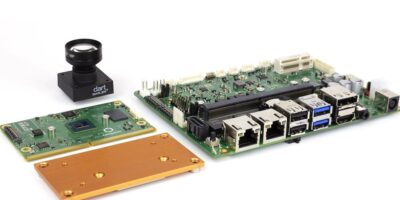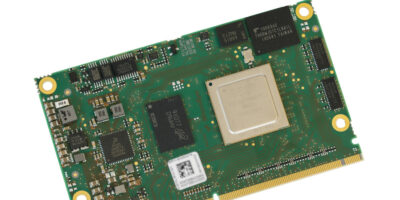For artificial intelligence (AI) accelerated intelligence embedded vision applications, congatec has announced the i.MX 8M Plus starter set based on a SMARC computer on module (CoM) with i.MX 8M Plus processor. The new processor from NXP has an integrated neural processing unit (NPU).
The i.MX 8M Plus processor delivers up to 2.3 Toperations per second (TOPS) performance for deep learning based AI. It can run inference engines and libraries such as Arm Neural Network (NN) and TensorFlow Lite. It also integrates seamlessly with Basler embedded vision software to give OEMs an application-ready embedded platform for the development of AI accelerated embedded vision systems.
The starter set contains the entire ecosystem developers need to instantly start designing applications for vision and AI integration, says congatec.
The SMARC 2.1 CoM conga-SMX8-Plus features four powerful Arm Cortex-A53 cores, one Arm Cortex-M72 controller and the NXP NPU to accelerate deep learning algorithms. It is also equipped with passive cooling.
The 3.5 inch carrier board conga-SMC1/SMARC-ARM directly connects the 13Mpixel Basler dart daA4200-30mci BCON for MIPI camera with an F1.8 f4mm lens via MIPI CSI-2.0 without any additional converter modules. As well as MIPI CSI-2.0, USB and GigE vision cameras are also supported.
congatec provides a bootable SD card with pre-configured boot loader, Yocto OS image, matching board support packages (BSPs), and processor-optimised Basler embedded vision software enabling immediate AI inference training on the basis of captured images and video sequences.
Typical applications range from price sensitive automated checkout terminals in retail environmetns to building safety, and from in-vehicle vision for navigation to surveillance systems in buses. They can also be used in industry, for example in human machine interfaces (HMIs) with vision based user identification and gesture based machine operation as well as vision supported robotics and industrial quality inspection systems.
The kit is designed to support the development of vision-based sytems. “A dedicated processing unit for neural algorithms that is supported by open source AI software solutions such as TensorFlow is an efficiency accelerator for many vision based systems,” said Martin Danzer, director product management at congatec. He added: ‟When all this is integrated as an application ready, hardware and software validated platform including Basler pylon Camera Software Suite, it puts developers on a fast track to designing NPU accelerated smart vision applications.”
The Basler pylon Camera Software Suite delivers a unified software development kit for BCON for MIPI, USB3 vision and GigE vision cameras, and enables camera access from source code, GUI or third party software. The high-performance pylon viewer allows for camera evaluation.
The congatec i.MX 8M Plus starter set for AI accelerated vision applications provides engineers instant access to AI-supported machine vision features such as triggering, individual image capture, and highly differentiated camera configuration options. There is also access to customised inference algorithms on the basis of the Arm NN and TensorFlow Lite ecosystem.







